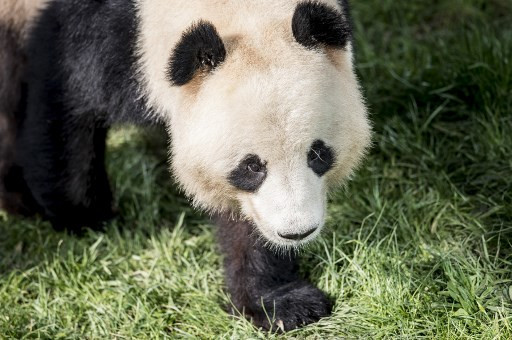 |
A giant panda named Xing Er at a zoo in Copenhagen.
|
In
China, the
giant panda is one of the most
charismatic of all animals on both national and global scales. Its image is famously portrayed on the
World Wildlife Fund logo and was chosen as the mascot for the 1990 Asian Games. Over the years, the panda has received significant global attention with regard to its conservation in its native China. Although the giant panda was able to successfully bounce back from the brink of extinction thanks to wide-scale conservation efforts on both national and international levels, other animals that share its habitat have suffered drastically in the hands of people. This was indicated in a recent study published in the journal
Nature Ecology and Evolution that conservation efforts directed at saving the giant panda failed to safeguard large predators living alongside it. Researchers found that four wild carnivores, the
leopard,
snow leopard,
gray wolf, and the
dhole (Asiatic wild dog), have almost vanished from the majority of giant panda conservation areas since the 1960s. The authors of the study compared and contrasted survey information from the 1950s to 1970s with data from nearly 8,000 camera traps taken between 2008 and 2018. They discovered that leopards had vanished from 80% of panda reserves, while snow leopards disappeared from 38% of the areas. Wolves, on the other hand, disappeared from 77% while dholes from 95%. The study pointed out that these predators face threats from
poaching,
logging, and disease. The authors stated that the crucial challenge was that while giant pandas have a home range of up to 13 square kilometers, the four large predators require an area surpassing 100 square kilometers. One of the authors,
Sheng Li of
Peking University's School of Life Sciences, explained that panda reserves usually have an area of around 300-400 square kilometers each which is too small to support reasonable populations of these predators.
).jpg/1280px-Flickr_-_law_keven_-_Feeling_Ruff...HBWE_Everybody..-O)).jpg) |
| The dhole is one of four large carnivores that has disappeared throughout China's giant panda reserves. |
It really disheartens me that the conservation efforts intended to save the giant panda failed to protect the four powerful predators in China. Although the panda is classified as a carnivore, it specializes in eating bamboo shoots and leaves and therefore plays an important role in maintaining China's bamboo numbers. The leopard, snow leopard, wolf, and dhole play a vital role in keeping China's wild herbivore populations in check. The news about this research study is a clear indication of why choosing to protect a species based solely on "charisma" can have an adverse effect on other species. Animals like the giant panda should not be protected simply because they play an influential role in the public mindset. They should be protected on the grounds of ecological importance. Without giant pandas, China's bamboo populations would cause ecological imbalance to the country's terrestrial ecosystem. Similarly, the loss of leopards, snow leopards, wolves, and wild dogs would result in overpopulation of various prey species. I strongly urge the government of China to take essential steps in restoring the country's natural habitats. This includes connecting current habitats over thousands of kilometers to allow segregated populations to mingle and possibly breed. This would probably recover the large predator populations and increase the resilience and sustainability of ecosystems for both pandas and other species.

).jpg/1280px-Flickr_-_law_keven_-_Feeling_Ruff...HBWE_Everybody..-O)).jpg)
No comments:
Post a Comment